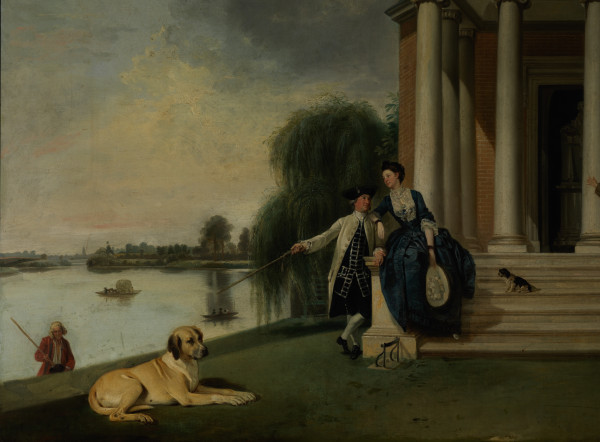Home
/
G1119
Paintings: G1119
Title
The Temple to Shakespeare at Hampton House with Mr. and Mrs. Garrick
Technique
Oil on canvas
Subject
Artist
Dimensions
height (canvas): 99.7 cm
width (canvas): 125cm
height (frame): 129cm
width (frame): 155cm
width (canvas): 125cm
height (frame): 129cm
width (frame): 155cm
Provenance
Purchase from Sotheby's in 2011, lot 38. The painting was commissioned by David Garrick in 1762 and was later sold during his widow's sale in London by Christie's, 23rd June 1823, lots 53 & 54.
Exhibition history
Rome, Hogarth Reynolds Turner: Pittura Inglese verso la modernita', Museo Fondazione Roma, Palazzo Sciarra, 2014 (both)
Newcastle-upon-Tyne, Royal Mining Engineering and Industrial Exhibition; Fine Arts Section, 1887, no. 1 (both);
Newcastle-upon-Tyne, Palace of Art, North East Coast Exhibition, 1929 (The Garden at Hampton House);
London, 25 Park Lane, English Conversation Pieces, 1930, nos. 107 & 151;
London, Royal Academy, British Art, 1934, no. 248 (The Garden at Hampton House);
Paris, Musee des Arts Décoratifs, Pavillon de Marsan, Exhibition of English Manners and Humour, 1938, no. 163 (The Garden at Hampton House);
London, Arts Council, British Sporting Painting, 1974, no. 65 (The Garden at Hampton House);
London, Arts Council, The Georgian Playhouse, 1975, nos. 82 & 83;
London, National Portrait Gallery, Johann Zoffany, 1733-1810, 14th January – 27th March 1977, nos. 11 & 12;
London, Tate Gallery, on loan 2007-2010 (both)
Related works
The Temple to Shakespeare at Hampton House with Mr. and Mrs. Garrick and The Garden at Hampton House with Mr. and Mrs. Garrick taking tea (G1120) are companion paintings, both painted in 1762, they have always been kept as a pair.
A pair with G1120, Zoffany’s conversation piece shows Garrick’s temple to Shakespeare on the lawn of his country house at Hampton. The full length marble statue of the bard just visible through the open door. Garrick stands with his wife on the steps and gestures with his cane, inviting the viewer to survey his grounds. The temple was erected in about 1757 when Garrick placed his commission for the statue with Jean Francois Roubiliac. The young boy playing in the temple is perhaps Garrick’s nephew George.
In 1779 after Garrick’s death an inventory of all his household furniture, paintings and other properties was compiled by his executors. Today this can be consulted in the National Art Library at the Victoria and Albert Museum. It provides a fascinating glimpse into his country house at Hampton and his town house at the Adelphi. From these we know the pair of paintings were originally part of four paintings commissioned from Zoffany that hung on the walls of Garrick’s town house as a reminder of his country estate. As a group they depict a prospect through his grounds, with Garrick depicted with his family throughout. From the steps of the temple you can see across the lawn and the vista depicted in G. Beyond can be seen the tree-lined was the entrance to a tunnel that Garrick had constructed to connect his two gardens, his land being intersected by the main road. Here in the third quartet (today in a private collection) we find Garrick’s nieces Arabella and Catherine at play. The final painting in the set (today in the private collection at Petworth House) completes the prospect with a view of the villa itself across the lawn showing the other entrance to the tunnel. Garrick is shown sitting at the bottom of his garden alone in quiet study. A receipt dated 23rd April 1763 for the four landscapes (together with other paintings) made out between Garrick and Zoffany can be found in the Garrick Club Library, bound into Henry Irving's "David Garrick: A Memorial" Volume 1. f 24.
In 1779 after Garrick’s death an inventory of all his household furniture, paintings and other properties was compiled by his executors. Today this can be consulted in the National Art Library at the Victoria and Albert Museum. It provides a fascinating glimpse into his country house at Hampton and his town house at the Adelphi. From these we know the pair of paintings were originally part of four paintings commissioned from Zoffany that hung on the walls of Garrick’s town house as a reminder of his country estate. As a group they depict a prospect through his grounds, with Garrick depicted with his family throughout. From the steps of the temple you can see across the lawn and the vista depicted in G. Beyond can be seen the tree-lined was the entrance to a tunnel that Garrick had constructed to connect his two gardens, his land being intersected by the main road. Here in the third quartet (today in a private collection) we find Garrick’s nieces Arabella and Catherine at play. The final painting in the set (today in the private collection at Petworth House) completes the prospect with a view of the villa itself across the lawn showing the other entrance to the tunnel. Garrick is shown sitting at the bottom of his garden alone in quiet study. A receipt dated 23rd April 1763 for the four landscapes (together with other paintings) made out between Garrick and Zoffany can be found in the Garrick Club Library, bound into Henry Irving's "David Garrick: A Memorial" Volume 1. f 24.






